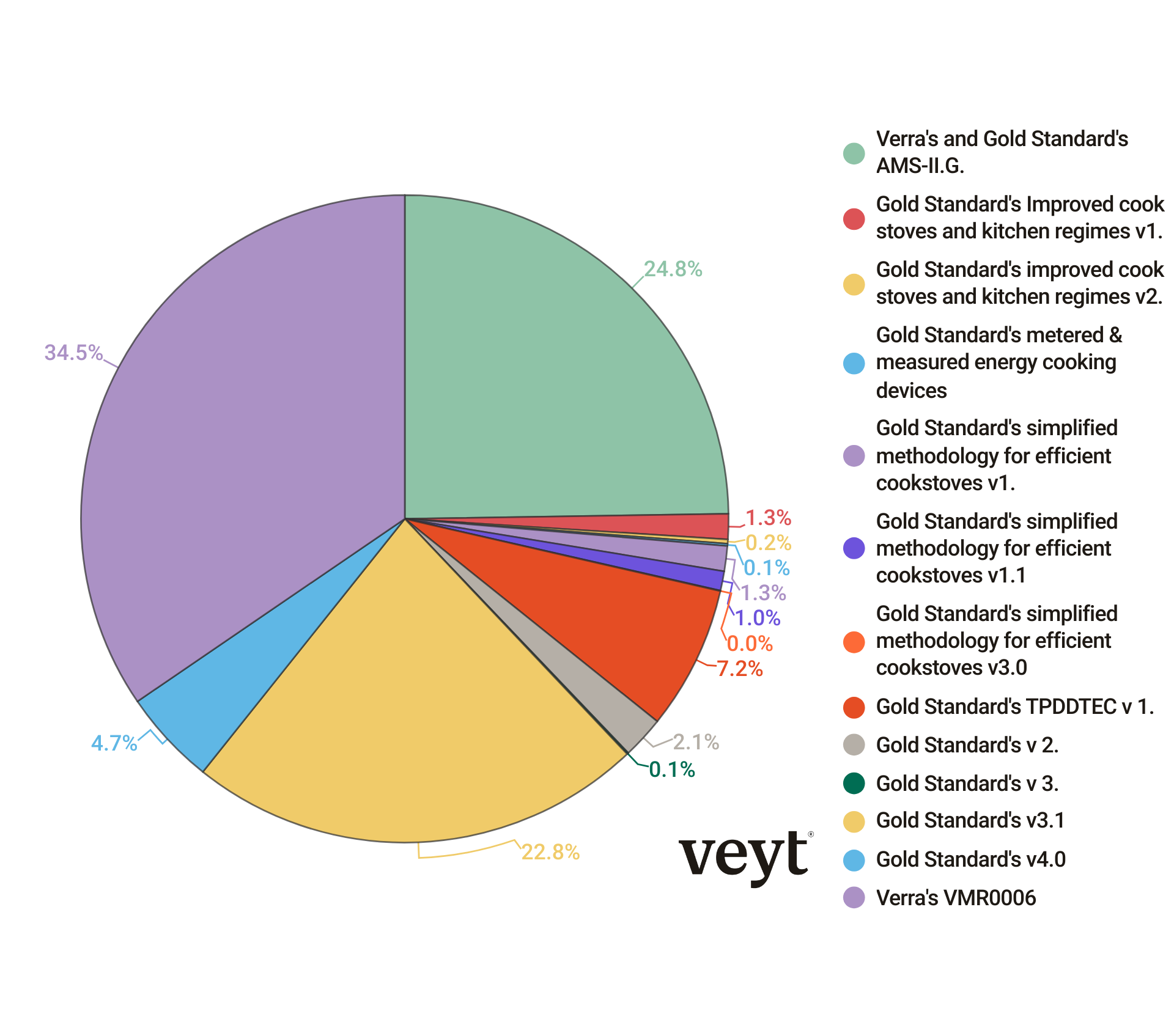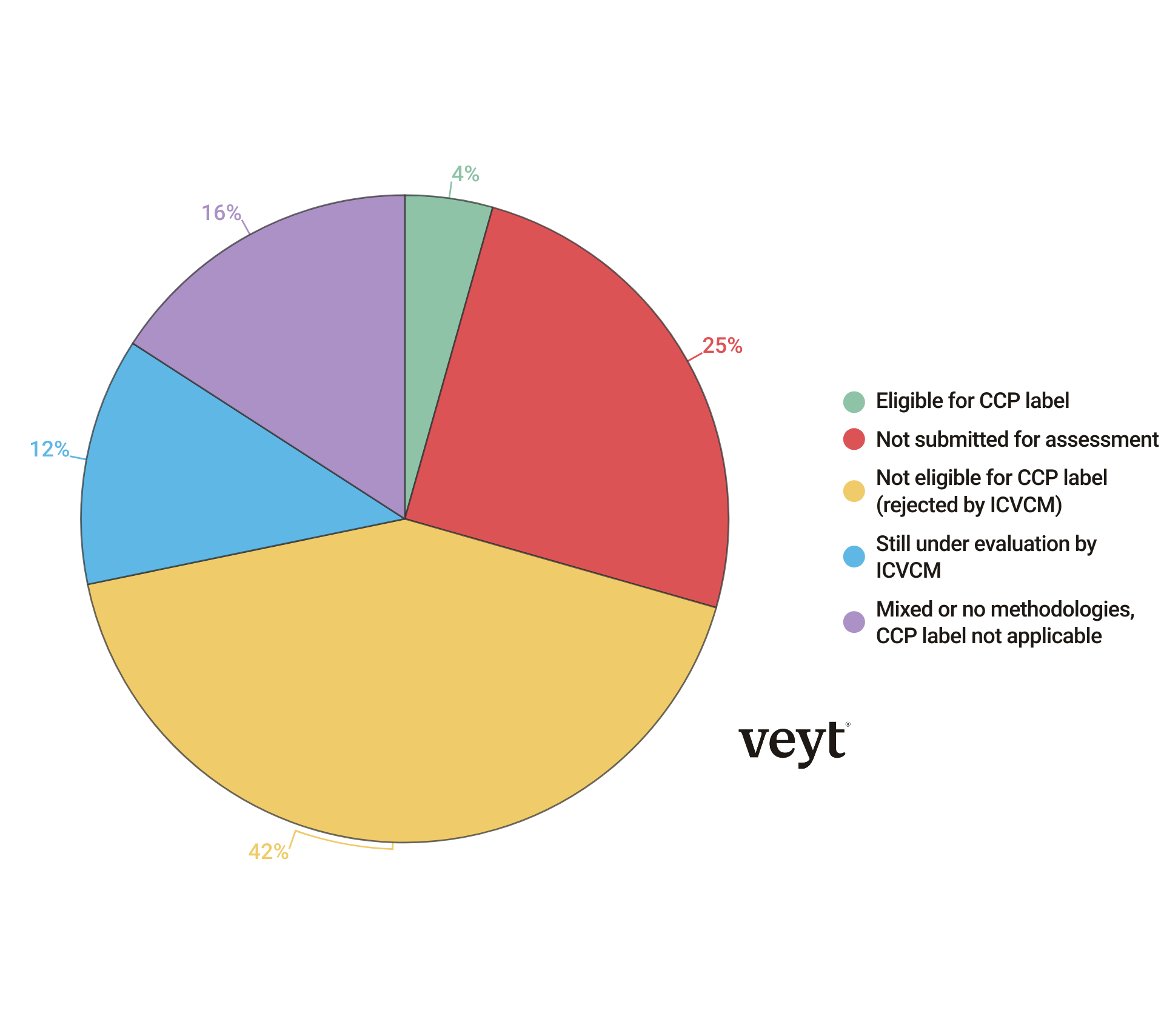The Integrity Council for the Voluntary Carbon Market (ICVCM) granted approval under its Core Carbon Principles (CCPs) label to three cookstove methodologies and one household biodigester methodology, but under strict conditions that render none of the credits in circulation from such projects eligible for the CCP designation. Two of the approved methodologies—Verra’s VM0050 and Gold Standard’s manure management—have yet to issue any credits.
Having emerged as an effort to weed out illegitimate standards and projects, the CCP label of the ICVCM constitutes a ‘seal of approval’ for carbon credits similar to fair trade labels on chocolate products or Forest Stewardship Council certification for wood/paper products. It is the result of ICVCM’s assessment of over 100 carbon credit methodologies across 36 project categories – an ongoing process since Q2 2024. Veyt tracks the assessment results as ICVCM approves or rejects certain carbon credit methodologies in batches, recently those from projects that avoid deforestation, commonly referred to as “REDD+” – see our analysis on these decisions. Last week’s cookstoves assessment result is the latest batch.
The premise of Veyt’s tracking of ICVCM decisions is that unlike compliance carbon markets, where the amount of allowances in circulation constitutes supply and the amount needed by covered entities to account for their emissions constitutes demand, the voluntary market’s “demand” for credits hinges on what attributes of the credit are desired by buyers. Buyers retire credits they can characterise as ‘high quality’ – especially amid ongoing controversy around the legitimacy of many offset standards and specific projects or project types. Accordingly, project proponents seek to adhere to the ICVCM-approved methodologies so that the credits their projects generate have the CCP label – those that do are assumed to fetch a premium for being ‘high quality.’
This dynamic affects the voluntary carbon market’s huge amount of credits in circulation – nearly 800 million units in the four biggest registries alone, each representing one metric tonne of greenhouse gas mitigation that has been issued to projects but that has not yet been “used” against an entity’s voluntary emission reduction target, such as a corporate net zero goal. “Using” such credits means retiring them, which in turn involves taking them out of circulation by cancelling them from their respective carbon credit registry.
Credits currently in circulation are unlikely to be used in the long term if they are not seen as ‘high quality.’ They will remain in their registries (as “non-retired” units) contributing to the stockpile of unwanted credits that do not constitute the voluntary market’s real “supply.” With the CCP label being a quality benchmark, Veyt updates the effect of ICVCM’s assessment process with respect to “real supply” each time there is a new decision on what credits get the CCP label.
This time, the two major registries affected by ICVCM’s verdict are Gold Standard and Verra, as the methodologies evaluated are primarily under their standards – see Table 1.
|
Methodology
|
Project category
|
ICVCM CCP status
|
|---|---|---|
|
Gold Standard’s Metered & Measured Energy Cooking Devices (v 1-1.2)
|
Clean cookstove
|
Approved
|
|
Gold Standard’s Technologies and Practices to Displace Decentralized Thermal Energy Consumption (TPDDTEC) (v4.0)
|
Clean cookstove
|
Approved
|
|
Verra’s VM00050 Energy Efficiency and Fuel-Switch Measures in Cookstoves (v1.0)
|
Clean cookstove
|
Approved
|
|
Gold Standard’s Animal Manure Management and Biogas Use for Thermal Energy Generation (v1.0)
|
Household biodigester
|
Approved
|
|
CDM’s AMS-II.G. – Energy efficiency measures in thermal applications of non-renewable biomass (v1-13.1)
|
Clean cookstove
|
Rejected
|
|
Gold Standard’s Simplified Methodology for Clean and Efficient Cookstoves (v1-3)
|
Clean cookstove
|
Rejected
|
|
CDM’s AMS-I.E. – Switch from non-renewable biomass for thermal applications by the user (v1)
|
Household biodigester
|
Rejected
|
|
CDM’s AMS-I.I. – Biogas/biomass thermal applications for households/small users (v1-6)
|
Household biodigester
|
Rejected
|
Two of the approved methodologies—Verra’s VM0050 and Gold Standard’s manure management—have yet to issue any credits.
Since cookstove activities have come under scrutiny for issuing far more credits than the emissions they actually reduced, projects using the four approved methodologies can only get the CCP label if they calculate the emissions reduced even more conservatively. They must use the modeling fuelwood savings scenario (MoFuSS) to estimate the project’s non-renewable biomass fractions (fNRB), and the fNRB must be under 0.5 even though the average for this type of project is 0.86. Also required are performance tests that monitor cookstoves’ fuel consumption, called Kitchen Performance Tests or Controlled Cooking Tests.
Veyt data indicates that none of the 12 million household biodigester credits currently in circulation meet those requirements for CCP approval. About 4 million cookstove credits issued by Gold Standard—roughly 4% of the 82 million cookstove credits in circulation—could qualify for the CCP label if they undergo retroactive adjustments that Gold Standard (as the credit issuer) would have to perform. Doing so involves project proponents paying additional issuance fees and results in fewer credits overall – although those credits then have the CCP label. Such a retroactive adjustment is known as a reconciliation process – see our explanation of Verra’s reconciliation here.
Given that Gold Standard has yet to finalise its approach to reconciliation and that it will cost project proponents more while resulting in fewer credits from the projects in question, we find it highly unlikely that any of the eligible credits currently in circulation will be endowed with the CCP label. This means the approximately 94 million cookstove and biodigester credits in circulation can be considered part of the growing surplus for which there is limited market demand.
*The CCP approval also applies to household biodigester methodologies, but only one (Gold Standard’s Animal Manure Management and Biogas Use for Thermal Energy Generation) passed muster – none of the 18 certified projects using this methodology have been issued any credits yet.

However, Veyt’s data shows that carbon credit quality is in the eye of the beholder: while CCP approval is an important measure, retirement behaviour reveals low levels of correlation (so far) between having the CCP label and being retired. Renewable energy credits continue to be retired at high volumes despite the fact that ICVCM rejected most of them for CCP approval in August 2024. Credits generated by projects using the ACM0002 methodology for renewable energy, for instance, are still the most frequently-retired type of credit six months after ICVCM deemed that methodology non-additional. Similarly, credits continue to be issued to projects using the ACM0002 methodology – in fact those from projects involving ACM0002 accounted for the majority of credits issued in the first two months of 2025.
One reason the price premium associated with the CCP label is not (yet) widely reflected in project developers’ and buyers’ behaviour is that most carbon credit transactions happen over the counter in bilateral transactions. Corporate entities partner with project developers and have longstanding direct offtake agreements for their credits: changing these in favour of projects whose credits have the CCP label involves changing existing credit purchase contracts or switching to new offtake parameters, which may only make financial sense to sellers if the CCP premium is very high.
Thus it is too early to tell what impact CCP approval has on distinguishing “real supply” from unwanted surplus in the nearly 800 million carbon credits sitting unretired in registries: so far only 4% of total credits in circulation—approximately 35 million—have been deemed eligible for the CCP label by the ICVCM.
More than 40% of the credits in circulation—primarily from renewable energy projects—have been deemed ineligible for the CCP seal after being “rejected” by the Integrity Council. This category (yellow in Figure 2) also includes credits that follow approved methodologies but are not labeled as CCP-eligible in the registry, often because the ICVCM has approved only recent versions of certain methodologies, thereby excluding older credits calculated using outdated methods.
Another 25% of the credits in circulation are linked to methodologies that registries did not even submit for ICVCM assessment. This includes Verra’s VMR0006 for cookstove projects, as well as VM0007, VM0009, and VM0015 for REDD projects. Additionally, 16% of circulating credits originate from projects without a clearly defined methodology or ones that combine multiple methodologies, as well as credits issued under the ARB compliance offset protocol for ACR and the Climate Action Reserve (CAR).
Another 12%—just under 100 million credits—come from project types still being evaluated by the ICVCM. These could become eligible as the assessment process progresses – project types still being evaluated include afforestation and reforestation, improved forest management, water purification, and rice cultivation. Veyt updates the status of what constitutes “real supply” every time the ICVCM publishes a new assessment result.

When it comes to evaluating carbon credit quality, ICVCM is not the only entity in town: other quality criteria are at play for carbon credits globally. The Paris Agreement Crediting Mechanism’s (PACM) Methodology Expert Panel (MEP) also evaluates carbon project methodologies for quality. Four of the six methodologies rejected by ICVCM for obtaining the CCP label (ACM0002 and AMS-I.D. for renewable energy, AMS-II.G for cookstove, AMS-I-E for household biodigester) are now under review by the PACM, effectively pitting the two ‘seals of approval’ against each other.
Meanwhile, ICAO’s TAB approved credits from projects involving clean cookstoves (those calculated using AMS.II-G), but only those issued by Gold Standard – not those issued by Verra. The TAB recommends to ICAO which units air carriers subject to CORSIA (the global program to cut greenhouse gas emissions growth from international aviation) may use for compliance to that program’s targets. The TAB’s recommendations resemble those of ICVCM when it comes to cookstove credits: those from methodology VMR0006 (the one withdrawn by Verra from the ICVCM assessment) and AMS-II.G (rejected by ICVCM after being submitted by Verra and Gold Standard) are not eligible for airlines’ compliance under CORSIA.
To discover how our advanced analytical tools can support your initiatives, reach out to our team at contact@veyt.com.
Veyt specialises in data, analysis, and insights for all significant low-carbon markets and renewable energy.